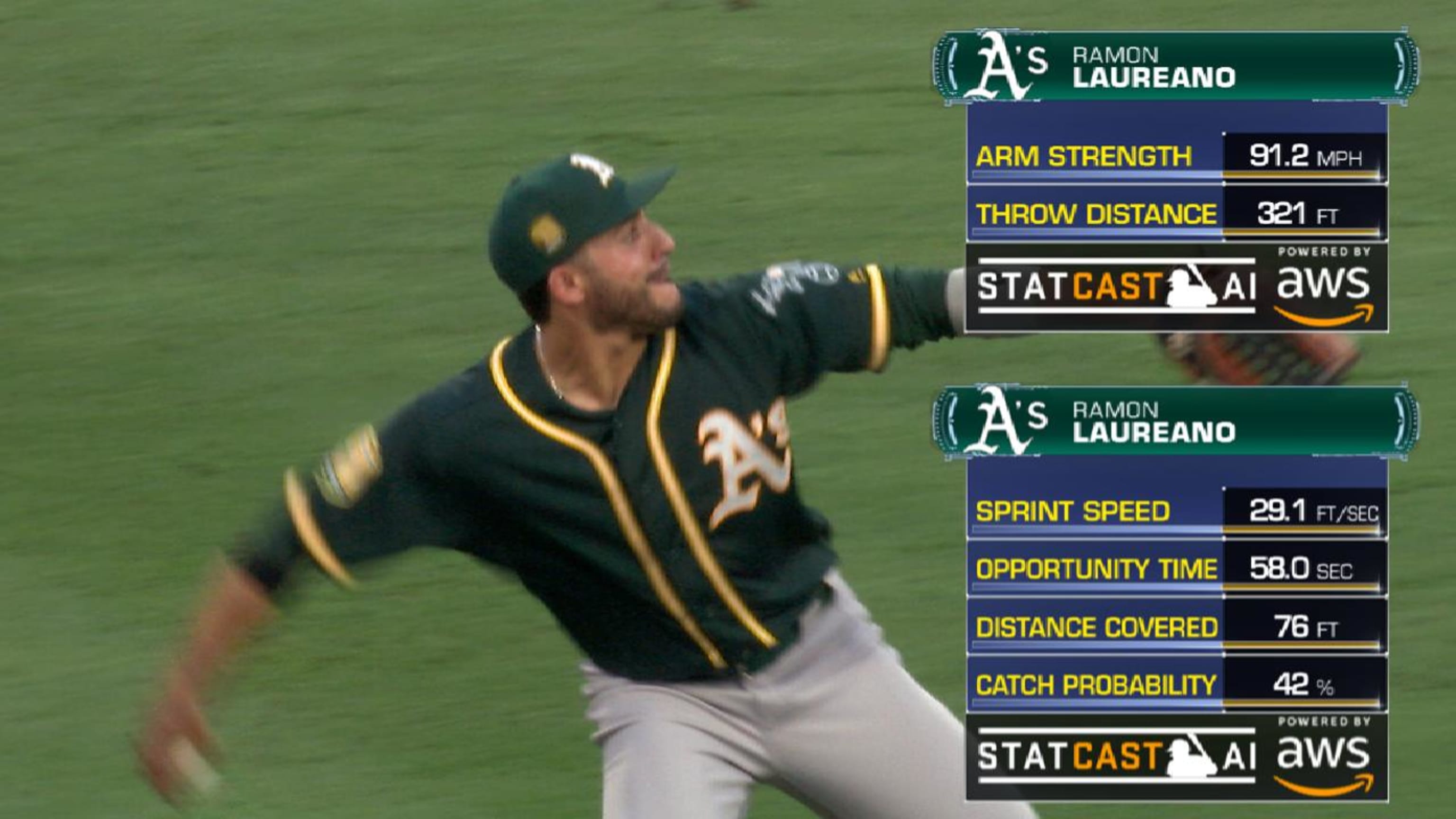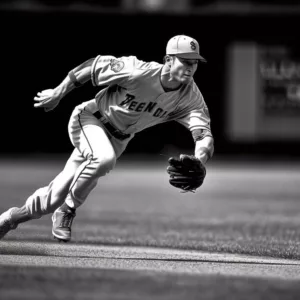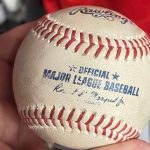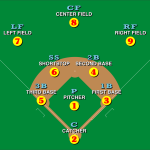MLB outfielders typically throw with speeds ranging from 85 to 100 miles per hour. In baseball, outfielders are known for their strong arms, allowing them to deliver accurate and powerful throws to the infield or home plate.
In the game of baseball, the outfielders play a crucial role in the defense. Positioned in the outfield, they are responsible for catching fly balls and making throws to different areas of the field. One important aspect of their game is their throwing ability.
MLB outfielders are known for their strong and accurate throws, which can have a significant impact on the outcome of a play. The throwing speed of MLB outfielders is impressive, with most of them capable of throwing the ball between 85 to 100 miles per hour. This allows them to get the ball quickly back to the infield or home plate, preventing baserunners from advancing or scoring. Their strong arms are developed through years of training, practice, and physical conditioning. Not only do outfielders need strong arms, but they also need accuracy in their throws. They must be able to hit their target consistently, whether it’s the cutoff man, a specific base, or home plate. Accuracy ensures that the ball reaches its intended destination without unnecessary delay or errors. MLB outfielders possess impressive throwing abilities, with speeds ranging from 85 to 100 miles per hour. Their strong and accurate throws are essential for preventing runs and contributing to the success of their team’s defense.

Credit: www.mlb.com
Factors Affecting The Speed Of Mlb Outfield Throws
MLB outfielders’ throw speed is influenced by several factors, including arm strength, technique, field conditions, and the distance to the target. These elements play a crucial role in determining how fast the ball can be thrown from the outfield.
Outfielders in Major League Baseball (MLB) play a critical role in the game, as their throwing abilities can directly impact the outcome of a play. The speed at which an outfielder throws the ball can be influenced by several factors. Understanding these factors can help explain why some outfielders have stronger arms and are able to make accurate and powerful throws. In this article, we will explore the three main factors that affect the speed of MLB outfield throws: the effect of arm strength, throwing technique, and field conditions.Effect Of Arm Strength
Arm strength is a crucial factor in determining how fast an outfielder can throw the ball. The muscles in the arm, particularly the shoulder and the triceps, play a key role in generating the necessary velocity. Outfielders with stronger muscles can generate more power and transfer it efficiently to the ball, resulting in faster throws. Additionally, factors such as genetics and training can contribute to the development of exceptional arm strength in some players.Effect Of Throwing Technique
While arm strength is important, the throwing technique is equally vital in maximizing the speed of an outfield throw. Proper mechanics can help outfielders achieve a more efficient transfer of energy from their body to the ball. This includes elements such as footwork, body positioning, and arm action. Outfielders who have mastered the correct throwing technique can generate more force and accuracy in their throws, leading to quicker release and higher throwing speeds.Effect Of Field Conditions
The condition of the field can affect the speed of MLB outfield throws as well. Outfielders need to carefully consider variables such as wind speed, grass length, and surface conditions when making a throw. For instance, a strong headwind can slow down the ball mid-flight, reducing its speed. On the other hand, a fast and firm outfield surface can allow the ball to roll smoothly, increasing the overall distance of the throw. These field conditions can either enhance or hinder the speed and accuracy of an outfielder’s throw. In conclusion, several factors contribute to the speed at which MLB outfielders throw the ball. Arm strength, throwing technique, and field conditions all play essential roles. By assessing and improving these factors, outfielders can enhance their throwing abilities and provide their teams with a vital weapon in the game.Average Throwing Speed Of Mlb Outfielders
When it comes to the speed, precision, and power on display in Major League Baseball, the outfielders play a crucial role. These athletes are known for their ability to cover vast amounts of ground and make incredible catches, but how fast can they throw the ball? In this section, we will explore the average throwing speed of MLB outfielders, comparing it with other positions, discussing historical trends, and examining the factors that influence their throwing speed.
Comparison With Other Positions
Compared to other positions on the field, outfielders tend to have the strongest throwing arms. While infielders need to make quick and accurate throws over shorter distances, outfielders require the ability to launch the ball long distances with incredible velocity. On average, outfielders can throw the ball at speeds ranging from 85 to 95 miles per hour (mph).
| Position | Average Throwing Speed (mph) |
|---|---|
| Outfielder | 85-95 |
| Infielder | 70-85 |
| Catcher | 80-90 |
| Pitcher | 90-100+ |
Historical Trends
Over the years, the average throwing speed of outfielders has witnessed a significant increase. This can be attributed to advancements in training methods, improved strength and conditioning programs, and a greater emphasis on arm strength development. Additionally, the use of sophisticated technology to measure and analyze player performance has allowed outfielders to fine-tune their throwing techniques and gain an edge on the field.
Factors Influencing Throwing Speed
A variety of factors can influence the throwing speed of MLB outfielders. These factors include:
- Arm Strength: A player’s natural arm strength plays a vital role in determining their throwing speed. This can be developed and improved through targeted strength training exercises.
- Throwing Mechanics: The proper technique, including footwork, arm angle, and follow-through, can contribute to maximizing throwing speed.
- Experience: Outfielders with years of professional experience often have a better understanding of how to generate power and accuracy in their throws.
- Field Conditions: The type of playing surface and weather conditions can affect the grip and release of the ball, ultimately impacting the speed of the throw.
By considering these factors and working on improving their throwing skills, MLB outfielders continue to push the boundaries of what is possible in terms of throwing speed in the game of baseball.
Training And Techniques To Improve Outfield Throwing Speed
HTML Format Response:When it comes to the game of baseball, the outfielders play a crucial role in the defense of the team. One of the key aspects of their performance is their ability to throw accurately and with speed. In this blog post, we will explore the training and techniques that can help improve outfield throwing speed.
Strength And Conditioning Exercises
Proper strength and conditioning are essential for outfielders looking to improve their throwing speed. By incorporating specific exercises into their training routine, outfielders can enhance their arm strength and power. Here are a few effective exercises:
- Weighted Throws: This exercise involves throwing a weighted ball to increase arm strength.
- Resistance Band Pulls: Using resistance bands can help strengthen the muscles used in throwing motions.
- Rotator Cuff Exercises: Targeting the rotator cuff muscles can help prevent injuries and improve throwing velocity.
- Explosive Push-ups: These push-ups work the chest, arms, and shoulders, helping to generate power for stronger throws.
Throwing Drills And Practice Routines
Regular practice is crucial to improve outfield throwing speed. By incorporating specific drills into their training sessions, outfielders can refine their technique and develop better throwing mechanics. Here are a few drills that can help:
- Long Toss: This drill involves throwing the ball as far as possible to increase arm strength and improve accuracy.
- Crow-Hop Drill: By practicing the crow-hop technique, outfielders can generate more power and distance in their throws.
- Quick Release Drill: This drill focuses on improving reaction time and shortening the time it takes to release the ball.
- Target Practice: Setting up targets at different distances helps outfielders work on their accuracy and consistency.
Importance Of Proper Mechanics
Along with strength and conditioning exercises and specific drills, it is crucial for outfielders to focus on proper throwing mechanics. A strong throwing arm alone is not enough if the mechanics are flawed. Here are a few key points to consider:
- Footwork: Good footwork is vital for generating power and accuracy in a throw.
- Arm Action: The arm should follow a fluid and natural motion, allowing for maximum velocity and control.
- Follow-through: A proper follow-through ensures that the ball is released with full extension, resulting in a stronger throw.
- Grip and Release: The grip and release of the ball play a significant role in the trajectory and accuracy of the throw.
By focusing on these key points and incorporating strength and conditioning exercises, throwing drills, and proper mechanics into their training, outfielders can significantly improve their throwing speed and accuracy. Consistent practice and dedication are essential for continued progress and performance enhancement.

Credit: tht.fangraphs.com

Credit: www.mlb.com
Frequently Asked Questions On How Fast Do Mlb Outfielders Throw?
Q: How Fast Do Mlb Outfielders Throw?
A: MLB outfielders can throw the ball at incredible speeds, typically ranging from 90 to 100 miles per hour. They possess strong arms, allowing them to make accurate and powerful throws to home plate or cut off runners on the bases.
Q: What Factors Contribute To The Throwing Speed Of Mlb Outfielders?
A: Several factors affect the throwing speed of MLB outfielders, including arm strength, technique, footwork, and body mechanics. Training and practice play a crucial role in developing the necessary power, accuracy, and quick release needed to make strong and efficient throws.
Q: How Does Outfield Throwing Ability Impact The Game?
A: Outfield throwing ability is crucial as it can influence the outcome of a game. Strong and accurate throws can prevent runners from advancing or scoring, minimize extra bases, and intimidate baserunners leading to cautious decisions on the basepaths.
Q: Can Mlb Outfielders Throw Faster Than Pitchers?
A: Generally, pitchers have stronger arms and can achieve higher throwing velocities compared to outfielders. However, there are exceptional outfielders who can match or come close to pitcher’s throwing speeds, especially during game-saving throws or attempting to throw out a runner at home plate.
Conclusion
MLB outfielders possess exceptional throwing abilities, often reaching impressive speeds. The average throw speed of an outfielder is around 85-95 mph, with some players even exceeding 100 mph. Their strength and accuracy are vital in ensuring their teammates can make crucial plays and prevent opposing runners from advancing.
With intense training and natural talent, these outfielders continue to showcase their remarkable throwing abilities in the world of baseball.

General Manager & Auditorial Head.
Killian Jake is a World Sports Traveler and hobbyist sports lover. By exploring different sorts of playing modules like indoor, outdoor, and many more. As for professionalism and writing, it’s helpful to give you the right suggestions on different games and sports.




